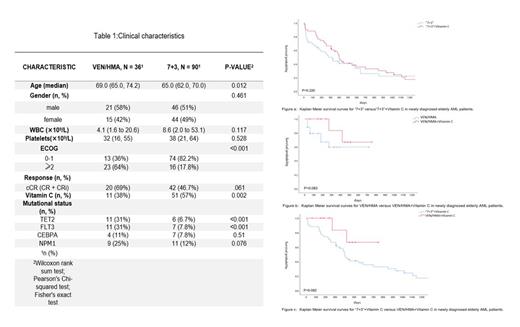Background: Vitamin C deficiency is frequently observed in AML patients compared to the normal population (Huijskens, et al. 2016; Liu, et al. 2016), and in vitro and in vivo studies have demonstrated that Vitamin C improves the response of AML patients to demethylated drug epigenetic therapy by directly regulating the activity of TET enzymes (Liu, et al. 2016; Zhao, et al. 2018). In addition, a number of in vitro and in vivo studies have shown that Vitamin C selectively kills cancer cells by generating ROS and can enhance the activity of chemotherapy drugs (Chen, et al. 2007; Verrax and Calderon 2009; Yun, et al. 2015). Today, optimal treatment for elder AML patients remains challenging, and treatment options include intensive chemotherapy (anthracyclines combined with cytarabine, known as “7+3”), hypomethylated drugs (HMA), and the addition of venetoclax to HMAs (azacytidine or decitabine) significantly improve median OS(DiNardo, et al. 2020; Ossenkoppele and Löwenberg 2015). However, it is unclear whether Vitamin C has a synergistic effect with chemotherapy and demethylated drug therapy in elderly patients with AML. Our objective was to investigate whether adding Vitamin C to “7+3” or VEN/HMA can improve the efficacy and survival of elderly AML patients.
Patients and methods: A retrospective cohort study of newly diagnosed elderly AML patients treated with a “7+3” regimen or HMA/Ven from 2010 to 2023 at the First Affiliated Hospital of Anhui Medical University, following approval by an institutional ethics Review committee, was conducted. The analysis included 126 patients. Collect clinical, demographic and genomic data. In SPSS (v.26), bilateral Student's t test or one-way ANOVA were used for inter-group difference analysis, Chi-square test was used to analyze the composite complete remission rate, and Kaplan-Meier method was used for survival analysis.
Result: The median age of patients in the “7+3” cohort was 65 years, and the median age of patients in the VEN/HMA cohort was 69 years. Compared with VEN/HMA cohort, patients in the “7+3” cohort had better physical status(p<0.001)(Table 1). Compared with the patients in the “7+3” cohort, the cCR (CR+CRi) in the VEN/HMA cohort was not statistically significant (Table 1). The cCR (CR+CRi) rates of VEN/HMA + Vitamin C and “VEN/HMA” treatment after 1 cycle were 82% and 68% (p=0.69). Compare OS between queues, the median OS (mOS) was 400 days in the “7+3” + Vitamin C cohort and 276 days in the “7+3” cohort (Figure a, p=0.220). Additionally, VEN/HMA+Vitamin C patients demonstrated a superior, yet not statistically significant, median overall survival (OS) benefit compared to VEN/HMA (median OS not reached, Figure b, p = 0.083).
Conclusion: VEN/HMA and “7+3” are effective frontline treatment options with similar response rates in newly diagnosed elderly AML. Additionally, the overall survival in VEN/HMA+Vitamin C appeared to be better, but did not reach statistical significance. Our data demonstrated that in the VEN/HMA cohort, VEN/HMA+Vitamin C the OS was longer and approached statistical significance. Future prospective trial designs or larger cohorts are needed to confirm these findings.
Disclosures
No relevant conflicts of interest to declare.


This feature is available to Subscribers Only
Sign In or Create an Account Close Modal